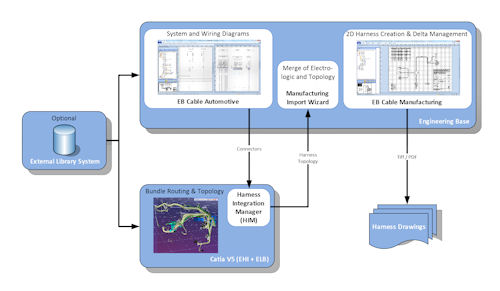Integration Shortens Wiring Harness Design Processes
New CATIA linkage enables parallel electronic and mechanical wire harness design.
Latest News
October 23, 2013
 A new linkage between CATIA V5 and the Engineering Base Cable wire harness design system from AUCOTEC enables mechanical and electrical engineers to work in parallel and synchronize their data at any time. Image courtesy of AUCOTEC. |
EB Cable is one of four solutions that make up the Engineering Base (EB) platform for the design, documentation, and lifecycle management of electrical control systems ranging from machines to plants to transportation systems. Engineering Base’s functionality extends from creating flow diagrams through control and electrical engineering in large-scale plants to the modular on-board networks found in automobiles.
Database-driven, EB is a trans-disciplinary collaborative system that can handle multiple power station units and cabinets—even individual sensors. Networked systems can be developed and displayed with all their relationships and connections between all objects—electrical, pneumatic, or process engineering-related. Users can manage projects, and EB can tie into enterprise systems such as EDM and PDM. EB leverages Microsoft components and scales from an individual workstation to hundreds of users accessing a server via a corporate network.
In addition to EB Cable, other solutions in the platform suite are EB Electrical, which provides for general diagrams and cable run design; EB Instrumentation, which offers capabilities for P&ID editing for preliminary planning in process engineering and instrumentation; and EB Power for efficient process planning in energy distribution facilities.
EB Cable uses the EB data-driven architecture to provide a comprehensive, uniform, and consistent planning tool that interconnects all of the data relating to a wiring harness from the initial design through the deployment. It offers, says AUCOTEC “complete independence from the working method.” That is, users select the most efficient approach for the task at hand. For example, graphic representations of the wire harness are suitable for general diagrams and detail wiring can be handled more quickly using lists.
For working with harness diagrams, EB Cable enables you to specify the structure of the wiring harness with its segments and branches, connected plugs, and the splicing positions in a schematic representation. Protective materials such as tape or corrugated pipes are also assigned here. Everything takes place in a system based on a consistent data stock without special interfaces.
EB Cable also offers such features as functional block diagrams, physical block diagrams, and detail wiring in wiring diagrams. With functional block diagrams, the functional units and their logical connections display as overviews and appear in the data model in the functions section immediately. With physical block diagrams, your devices and modules are displayed as well as a specification of the wiring harnesses that connect them. For detail wiring in the wiring diagram, all of the information from the superordinate block diagrams is available. This, says the company, helps planning reliability from no matter the angle of viewing since everybody works on the same objects in the central database.
The new CATIA linkage enables electrical and mechanical design engineers to do their jobs in parallel and then synchronize their data at any time, which can save development time. After data synchronization, all changes are displayed and the responsible employee decides which changes are adopted. These decisions are recorded in a traceable manner.
By means of the HIM, CATIA V5 receives the electro-logical definitions from EB Cable. HIM transfers the wiring harness data that is processed in 3D (topology, length, protective material) back to EB Cable. The routing of the individual wires takes place there and the 2D wiring harness conductors and follow-up documentation are generated automatically.
Engineering Base Cable is also available as a complete solution for the electrical logic of wiring harnesses in automobiles. The system is designed to handle the interconnection of the components with diverse functions such as lights, audio system, and engine control. It then uses these specifications to specify the precise wiring setup for a specific car configuration. Wizards support the software’s automatic plug selection and placement, the cable definition, the specification of disconnection points, and the modular design of the wiring harness. The mechanical definition of the wiring harness can be done in Engineering Base or it can be transferred to production-related systems using the standardized KBL-XML interface.
The CATIA plug-in HIM that enables this interaction was developed by the Austrian Engineering Center Steyr, which is part of the Magna group. Earlier this year, AUCOTEC exclusively assumed all related rights and obligations. Intec takes care of the national and international support for future users of this link.
For more information on Engineering Base Cable, visit AUCOTEC.
Download the Engineering Base Cable brochure.
Download the Engineering Base Essentials brochure.
Read how Engineering Base connects harness designs at Porsche.
Sign up for a complimentary trial version of Engineering Base.
See why DE’s editors selected Engineering Base as their Pick of the Week.
Sources: Press materials received from the company and additional information gleaned from the company’s website.
Subscribe to our FREE magazine, FREE email newsletters or both!
Latest News
About the Author
Anthony J. Lockwood is Digital Engineering’s founding editor. He is now retired. Contact him via [email protected].
Follow DE





